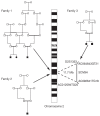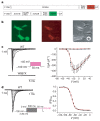An SCN9A channelopathy causes congenital inability to experience pain
- PMID: 17167479
- PMCID: PMC7212082
- DOI: 10.1038/nature05413
An SCN9A channelopathy causes congenital inability to experience pain
Abstract
The complete inability to sense pain in an otherwise healthy individual is a very rare phenotype. In three consanguineous families from northern Pakistan, we mapped the condition as an autosomal-recessive trait to chromosome 2q24.3. This region contains the gene SCN9A, encoding the alpha-subunit of the voltage-gated sodium channel, Na(v)1.7, which is strongly expressed in nociceptive neurons. Sequence analysis of SCN9A in affected individuals revealed three distinct homozygous nonsense mutations (S459X, I767X and W897X). We show that these mutations cause loss of function of Na(v)1.7 by co-expression of wild-type or mutant human Na(v)1.7 with sodium channel beta(1) and beta(2) subunits in HEK293 cells. In cells expressing mutant Na(v)1.7, the currents were no greater than background. Our data suggest that SCN9A is an essential and non-redundant requirement for nociception in humans. These findings should stimulate the search for novel analgesics that selectively target this sodium channel subunit.
Conflict of interest statement
The authors declare no competing financial interests. Correspondence and requests for materials should be addressed to C.G.W. (
Figures




Comment in
-
Neurobiology: a channel sets the gain on pain.Nature. 2006 Dec 14;444(7121):831-2. doi: 10.1038/444831a. Nature. 2006. PMID: 17167466 No abstract available.
-
Potential downsides of perfect pain relief.Nature. 2007 Mar 1;446(7131):24. doi: 10.1038/446024a. Nature. 2007. PMID: 17330023 No abstract available.
Similar articles
-
A stop codon mutation in SCN9A causes lack of pain sensation.Hum Mol Genet. 2007 Sep 1;16(17):2114-21. doi: 10.1093/hmg/ddm160. Epub 2007 Jun 27. Hum Mol Genet. 2007. PMID: 17597096
-
Congenital insensitivity to pain: novel SCN9A missense and in-frame deletion mutations.Hum Mutat. 2010 Sep;31(9):E1670-86. doi: 10.1002/humu.21325. Hum Mutat. 2010. PMID: 20635406 Free PMC article.
-
Mutations in sodium-channel gene SCN9A cause a spectrum of human genetic pain disorders.J Clin Invest. 2007 Dec;117(12):3603-9. doi: 10.1172/JCI33297. J Clin Invest. 2007. PMID: 18060017 Free PMC article. Review.
-
Loss-of-function mutations in the Nav1.7 gene underlie congenital indifference to pain in multiple human populations.Clin Genet. 2007 Apr;71(4):311-9. doi: 10.1111/j.1399-0004.2007.00790.x. Clin Genet. 2007. PMID: 17470132
-
Sodium channelopathies and pain.Pflugers Arch. 2010 Jul;460(2):249-63. doi: 10.1007/s00424-009-0779-3. Epub 2010 Jan 26. Pflugers Arch. 2010. PMID: 20101409 Review.
Cited by
-
Voltage Gated Sodium Channel Genes in Epilepsy: Mutations, Functional Studies, and Treatment Dimensions.Front Neurol. 2021 Mar 24;12:600050. doi: 10.3389/fneur.2021.600050. eCollection 2021. Front Neurol. 2021. PMID: 33841294 Free PMC article. Review.
-
Sensory neuron downregulation of the Kv9.1 potassium channel subunit mediates neuropathic pain following nerve injury.J Neurosci. 2012 Nov 28;32(48):17502-13. doi: 10.1523/JNEUROSCI.3561-12.2012. J Neurosci. 2012. PMID: 23197740 Free PMC article.
-
Discovery of a selective, state-independent inhibitor of NaV1.7 by modification of guanidinium toxins.Sci Rep. 2020 Sep 9;10(1):14791. doi: 10.1038/s41598-020-71135-2. Sci Rep. 2020. PMID: 32908170 Free PMC article.
-
Ion channel therapeutics for pain.Channels (Austin). 2015;9(6):344-51. doi: 10.1080/19336950.2015.1075105. Channels (Austin). 2015. PMID: 26218246 Free PMC article. Review.
-
Nav1.7 protein and mRNA expression in the dorsal root ganglia of rats with chronic neuropathic pain.Neural Regen Res. 2012 Jul 15;7(20):1540-4. doi: 10.3969/j.issn.1673-5374.2012.20.003. Neural Regen Res. 2012. PMID: 25657691 Free PMC article.
References
-
- Dearborn G. A case of congenital general pure analgesia. J Nerv Ment Dis. 1932;75:612–615.
-
- Dyck PJ, et al. Not ‘indifference to pain’ but varieties of hereditary sensory and autonomic neuropathy. Brain. 1983;106:373–390. - PubMed
-
- Landrieu P, Said G, Allaire C. Dominantly transmitted congenital indifference to pain. Ann Neurol. 1990;27:574–578. - PubMed
-
- Nagasako EM, Oaklander AL, Dworkin RH. Congenital insensitivity to pain: an update. Pain. 2003;101:213–219. - PubMed
-
- Klein CJ, Sinnreich M, Dyck PJ. Indifference rather than insensitivity to pain. Ann Neurol. 2003;53:417–418. author reply Ann. Neurol. 53, 418-419 (2003) - PubMed
Publication types
MeSH terms
Substances
Associated data
- Actions
Grants and funding
LinkOut - more resources
Full Text Sources
Other Literature Sources
Medical
Molecular Biology Databases


